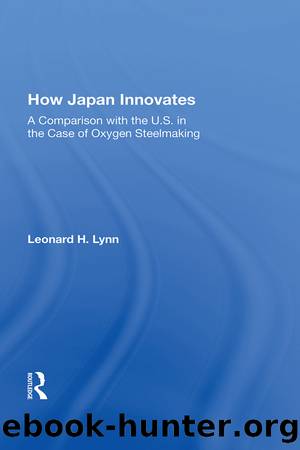How Japan Innovates: A Comparison With the U.S. In the Case of Oxygen Steelmaking by Leonard L Lynn

Author:Leonard L Lynn [Lynn, Leonard L]
Language: eng
Format: epub
Tags: Social Science, Political Science, World, Asian, Regional Studies
ISBN: 9780429716768
Google: zU2wDwAAQBAJ
Goodreads: 45913963
Publisher: Routledge
Published: 2019-04-18T00:00:00+00:00
Early Adopters and Late Adopters: Some Implications
The history of the BOF can be seen as a gradual reduction of uncertainty. When the NKK engineers visited Europe in 1951 the BOF had not yet been put into commercial use. It was not clear that this process could profitably be used to make steel at all. By 1953 the Austrians were claiming success with the technology, but even if the BOF were successful in Austria, it might not be viable in places where different types of iron or refractories would have to be used. Further reduction of uncertainty occurred in 1954 when Canadian and American steelmakers adopted the BOF. The Canadian steelmaker showed that a type of refractory brick that could be produced in Japan could be used in the BOF. New pollution control technology became available. Still, until 1957, no major steelmakers had adopted the BOF.
For the other Japanese steelmakers, Yawataâs interest in the BOF was a strong indication that the technology would succeed in Japan. Yawata was the leader of the industry and had been the main conduit of advanced foreign steelmaking technology since the Japanese government inaugurated the Yawata Works back in 1901. Yawataâs interest in the BOF helped convince NKK to adopt the process. A specific area of uncertainty was eliminated when the license agreement orchestrated by MIT I was signed and made public. Not only would the royalty cost be low, but firms adopting the BOF could have their employees trained by Yawata and NKK. Further patents related to the technology would be pooled and made available to all Japanese license holders. All license holders would also have the right to visit the plants of other license holders. Amagasaki, Kobe and Sumitomo quickly expressed their intention to build BOF facilities. Fuji expressed similar intentions, but redoubled its efforts to find an alternative steelmaking process. Kawasaki showed less interest in the new technology.
Before the license agreement was concluded, there had been considerable secrecy about the BOF in Japan. Because the agreement was based on a lump sum to be shared by all Japanese adopters, it was suddenly advantageous for Yawata and NKK to promote its use in Japan. Articles appeared in technical journals, and non-technical explanations for managers were published in such journals as Tekkokai. The Japan BOT committee was organized by Yawata and NKK to promote the sharing of BOF technology. All the BOF sublicensees were allowed to join the BOT committee.35 In 1956 a decisionmaker considering adoption of the BOF in Japan could refer to only two general technical articles on the process in the official Iron and Steel Institute of Japan journal Tetsu to hagane. Another article was published in 1957. In 1958, eleven new articles on the BOF appeared in Tetsu to hagane and five papers were presented at the first Japan BOT Committee technical meeting. The articles and papers included details on the construction, start-up and operations at the first BOF plants. The chemistry of the process was explained and for the first time details of Yawataâs pilot plant experiments were published.
Download
This site does not store any files on its server. We only index and link to content provided by other sites. Please contact the content providers to delete copyright contents if any and email us, we'll remove relevant links or contents immediately.
| Concrete | Extraction & Processing |
| Fracture Mechanics | Materials Science |
| Metallurgy | Polymers & Textiles |
| Strength of Materials | Testing |
Whiskies Galore by Ian Buxton(41941)
Introduction to Aircraft Design (Cambridge Aerospace Series) by John P. Fielding(33095)
Small Unmanned Fixed-wing Aircraft Design by Andrew J. Keane Andras Sobester James P. Scanlan & András Sóbester & James P. Scanlan(32767)
Craft Beer for the Homebrewer by Michael Agnew(18200)
Turbulence by E. J. Noyes(7983)
The Complete Stick Figure Physics Tutorials by Allen Sarah(7339)
Kaplan MCAT General Chemistry Review by Kaplan(6903)
The Thirst by Nesbo Jo(6882)
Bad Blood by John Carreyrou(6584)
Modelling of Convective Heat and Mass Transfer in Rotating Flows by Igor V. Shevchuk(6408)
Learning SQL by Alan Beaulieu(6239)
Weapons of Math Destruction by Cathy O'Neil(6220)
Man-made Catastrophes and Risk Information Concealment by Dmitry Chernov & Didier Sornette(5958)
Digital Minimalism by Cal Newport;(5707)
Life 3.0: Being Human in the Age of Artificial Intelligence by Tegmark Max(5519)
iGen by Jean M. Twenge(5387)
Secrets of Antigravity Propulsion: Tesla, UFOs, and Classified Aerospace Technology by Ph.D. Paul A. Laviolette(5336)
Design of Trajectory Optimization Approach for Space Maneuver Vehicle Skip Entry Problems by Runqi Chai & Al Savvaris & Antonios Tsourdos & Senchun Chai(5040)
Pale Blue Dot by Carl Sagan(4960)
